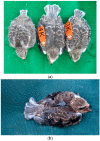Out of Africa: Juvenile Dispersal of Black-Shouldered Kites in the Emerging European Population
- PMID: 36009660
- PMCID: PMC9405462
- DOI: 10.3390/ani12162070
Out of Africa: Juvenile Dispersal of Black-Shouldered Kites in the Emerging European Population
Abstract
Knowledge of animal dispersal patterns is of great importance for the conservation and maintenance of natural populations. We here analyze juvenile dispersal of the poorly studied Black-shouldered Kite (Elanus caeruleus) monitored in southwestern Spain in an ongoing long-term study initiated in 2003. The European population of Black-shouldered kites is thought to be a recent one funded by colonizing African birds, as no kites have been found in the European fossil record, and the breeding population has progressively expanded to the North in the late 20th and 21st centuries. We obtained information on movements behavior during dispersal from 47 juveniles Kites after marking 384 nestlings with wing tags and three nestlings with radio transmitter. We have tested two competing hypotheses (i.e., the Resources Competition Hypothesis and the Wandering Hypothesis (WH)) that may explain the leptokurtic distribution of the natal dispersal distance in Elanus. After independence, juvenile females dispersed farther from the natal areas than males, as is common in birds. On average, males and females dispersed from their natal areas over 9 (i.e., 26.15 km) and 15 (i.e., 43.79 km) breeding territories, respectively. A male and two females dispersed further than 100 km from their natal nest. Our results indicated some evidence supporting the competition-for-resources hypotheses since nestlings hatched from high quality territories stayed closer from natal areas than nestlings hatched from low quality territories and also nestlings hatched first within the brood also tend to recruit closer to their natal area than later hatched nestlings which tend to disperse further away from their natal area. The information provided by these crucial demographic parameters will be used for the elaboration of future conservation plans for the management of this colonizing species in Europe.
Keywords: brood rank order; laying date; natal dispersal; range expansion; resource competition hypothesis; wandering hypothesis.
Conflict of interest statement
The authors declare no conflict of interest.
Figures





Similar articles
-
Determinants of departure to natal dispersal across an elevational gradient in a long-lived raptor species.Ecol Evol. 2023 Jan 16;13(1):e9603. doi: 10.1002/ece3.9603. eCollection 2023 Jan. Ecol Evol. 2023. PMID: 36694544 Free PMC article.
-
The variability of juvenile dispersal in an opportunistic raptor.Curr Zool. 2022 May 18;69(3):244-254. doi: 10.1093/cz/zoac039. eCollection 2023 Jun. Curr Zool. 2022. PMID: 37351299 Free PMC article.
-
Effects of social status on the dispersal behaviour of juvenile western screech-owls.Anim Behav. 1999 Apr;57(4):883-892. doi: 10.1006/anbe.1998.1050. Anim Behav. 1999. PMID: 10202096
-
Role of breeding and natal movements in lifetime dispersal of a forest-dwelling rodent.Ecol Evol. 2017 Mar 2;7(7):2204-2213. doi: 10.1002/ece3.2814. eCollection 2017 Apr. Ecol Evol. 2017. PMID: 28405284 Free PMC article.
-
Sex-biased dispersal: a review of the theory.Biol Rev Camb Philos Soc. 2019 Apr;94(2):721-736. doi: 10.1111/brv.12475. Epub 2018 Oct 24. Biol Rev Camb Philos Soc. 2019. PMID: 30353655 Free PMC article. Review.
Cited by
-
Generation of raptor diversity in Europe: linking speciation with climate changes and the ability to migrate.PeerJ. 2022 Dec 8;10:e14505. doi: 10.7717/peerj.14505. eCollection 2022. PeerJ. 2022. PMID: 36523450 Free PMC article.
References
-
- Clobert J., Danchin E., Dhondt A.A., Nichols J.D. Dispersal. Oxford University Press; Oxford, UK: 2001.
-
- Greenwood P.J., Harvey P.H. The natal and breeding dispersal of birds. Annu. Rev. Ecol. Syst. 1982;13:1–21. doi: 10.1146/annurev.es.13.110182.000245. - DOI
-
- Cresswell W. Migratory connectivity of Palaearctic–African migratory birds and their responses to environmental change, the serial residency hypothesis. IBIS. 2014;156:493–510. doi: 10.1111/ibi.12168. - DOI
-
- Berthold P. Bird Migration: A General Survey. Oxford University Press; Oxford, UK: 2001.
LinkOut - more resources
Full Text Sources

